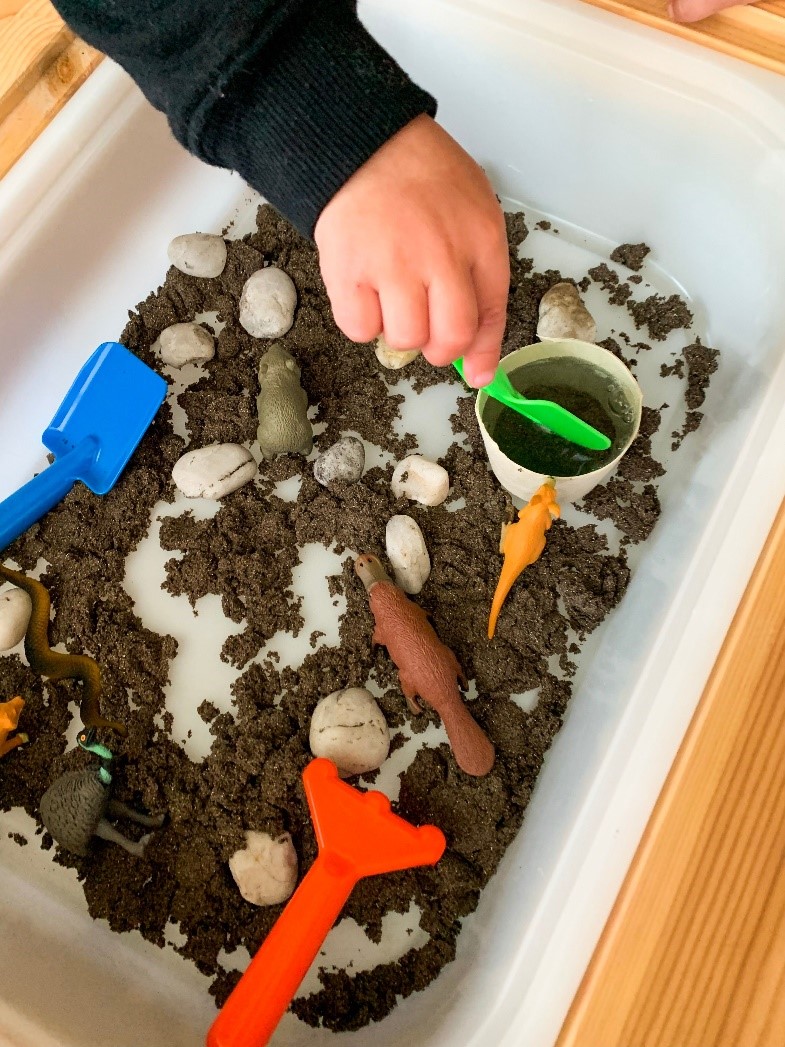What is Sensory Play?

Hi, I’m Tara! I am a Paediatric Occupational Therapist and a mum-of-two little boys.
For the last 11 years, I’ve been working with children with disabilities, and I feel very honoured to be able to walk alongside these families on their unexpected parenting journey.
What does a Paediatric Occupational Therapist do?
You might be wondering: what does a Paediatric Occupational Therapist do? If children are experiencing difficulties in their development, which impacts their ability to participate at home, at childcare, at school or in the community, I help them to build their skills in different areas (like playing, eating, sleeping, interacting, drawing, writing, learning, toileting, bathing, dressing, behaviour, sensory processing and emotional regulation) at the same time as upskilling parents, carers and teachers on how to best support their child.
The best part of my job is that we disguise learning tricky skills with super fun play activities. So, basically, I get to play all day! There is not a toy out there that I can’t find a learning or skill building opportunity for!
What is “Sensory” Play?
Sensory Play might sound like this magical concept that requires elaborate setups and resources but fear not... Sensory Play is literally anything that stimulates your child’s senses BUT it does have very important benefits!
We have our 5 main senses sight, hearing, touch, smell and taste and then 2 lesser-known senses - proprioceptive sense and vestibular sense. Our proprioceptive sense tells us about our body position from receptors in our muscles and joints, it is activated when we do movements such as pushing, pulling, lifting, squeezing, and stretching. Our vestibular sense provides information related to movement and head position. The vestibular sense is important for development of balance, coordination, eye control, attention, being secure with movement and some aspects of language development.
Anything that engages your sight, smell, hearing, touch, taste or requires you to move your body can be called a “sensory activity”. Picking what type of toys and materials you want to use is the hardest part as there is so much to explore but starting with something your child is going to be comfortable and interested in is the trick!
There are some amazing sensory toys now available and you have lots of resources in your kitchen pantry and cupboards to add to them to create wonderful sensory play activities!
Why is it important?
Besides being super enticing for little inquisitive minds, engaging in sensory play helps build new nerve connections in the brain which leads to children developing more complex learning pathways for all of life’s skills to come. There is so much evidence that states children learn best by doing, touching, feeling and experiencing which is why using sensory items in learning activities and play is magic!
Engaging children in sensory play activities works on;
- Language development – creating opportunities for new words
- Fine and gross motor development – scooping, pouring, squeezing, lifting, pulling, pushing you name the action, it can be done during sensory play!
- Problem solving skills – how does it? How can I do it differently? What else can I do?
- Social interaction skills – play shared with another person is wonderful for development
- Cognitive development – learning cause and effect, how things work, concepts and logic
- Increases tolerance for self care activities such as bathing/showering
- Improves tolerance for being messy
Top tips for successful Sensory Play:
- 1.Have FUN! Be prepared to get messy with them and model confident playing;
- 2.Use your child’s interests to help engage them in the play eg. their favourite toys;
- 3.Offer utensils such a spoon or a cup to use with sensory play if your child is hesitant to touch with bare hands;
- 4.Be prepared for mess, have wipes/towels etc on hand.
- 5.Be mindful of your reaction – if your face, words or body language says its is yuck/dangerous then your child will pick up on this and be hesitant too;
- 6. There are no ‘rules’ with how your child engages with the sensory items as long as it’s safe;
- 7.Provide close supervision at all times to ensure safety e.g nothing is swallowed.
Sensory Play Ideas
Activity 1: Ocean Sensory Tub
Products used: Orbeez water beads, Kinetic Sand and Wild Republic Ocean Animals. From home: Plastic tub, cup and spoons.

Activity 2: Land Sensory Tub
Products used: Kids Play Dirt pack and Wild Republic Australian animal’s pack.
From home: Plastic tub, cup, water and stones from garden. Myles can we link to the above products on the website?

Fidget Box:
Toys that you can “fidget” with are more than just the latest craze or a way to pass time. They are a tool to help calm busy minds, nervous bodies and help with self regulation. Meaning they have a calming impact on the central nervous system and increase attention and focus. Additionally, they also often require problem solving skills and persistence, strengthen the small muscles in the hands, improve coordination and fine motor skills as well as providing a range of sensory ‘tactile’ experiences. Tiny but mighty! Fidget boxes are great for long travel journeys, to keep in the car, to give your child when feeding their baby sibling and as a quite calm down activity after a big day at school or whenever needed.
There are so many objects out there that can be used as a ‘fidget’ which is perfect as you can make a box that suits your child’s interests, skills and age! There is something out there for everyone and the options are endless at Toymate!




































































